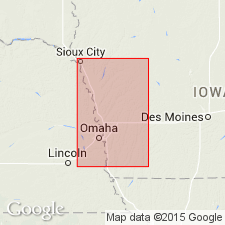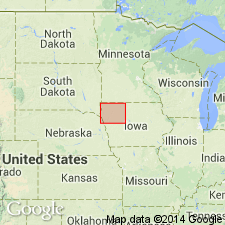
- Usage in publication:
-
- Woodbury sandstones and shales
- Modifications:
-
- First used
- Dominant lithology:
-
- Sandstone
- Shale
- AAPG geologic province:
-
- Iowa shelf
Summary:
First published use as a name for some sandstone and shale in Woodbury Co, IA on the Iowa shelf that overlie the Nishnabotany sandstone (first used) and underlie the INOCERAMUS beds. Has not been recognized outside of Woodbury Co. Best exposures are at Sargent's Bluff 7 mi below Sioux City, at Sioux City, and along bluffs of the Big Sioux River to northwest corner of county. Has a maximum thickness of 150 ft. Fossils: leaves, fish scales. Of Cretaceous age.
Source: GNU records (USGS DDS-6; Denver GNULEX).

- Usage in publication:
-
- Woodbury Member
- Modifications:
-
- Revised
- Overview
- AAPG geologic province:
-
- Iowa shelf
Summary:
Revised in that Woodbury assigned as the upper member of the Dakota Formation and that its upper contact coincides with the Dakota-Graneros contact. This placement of its upper contact differs from White (1870) in that it is more restrictive. White included beds up to the base of the base of the INOCERAMUS beds or to the base of the Greenhorn Limestone. Overlies Nishnabotna Member, lower member of Dakota, formerly spelled Nishnabotany; contact is locally gradational. Crops out in Woodbury Co, IA, on the Iowa shelf. Consists of a complex interbedded assemblage of very fine to medium grained, friable, calcite-, geothite-, or limonite-cemented, or non-cemented sandstone. Can be micaceous. Can be interbedded with gray to red shale or mudstone, lignite, and siltstone. Pyrite and siderite nodules common. Sandstones may be trough and tabular cross-bedded, have ripple-marks. Deposited in a meander or fluvial-deltaic system.
Source: GNU records (USGS DDS-6; Denver GNULEX).
For more information, please contact Nancy Stamm, Geologic Names Committee Secretary.
Asterisk (*) indicates published by U.S. Geological Survey authors.
"No current usage" (†) implies that a name has been abandoned or has fallen into disuse. Former usage and, if known, replacement name given in parentheses ( ).
Slash (/) indicates name conflicts with nomenclatural guidelines (CSN, 1933; ACSN, 1961, 1970; NACSN, 1983, 2005, 2021). May be explained within brackets ([ ]).

